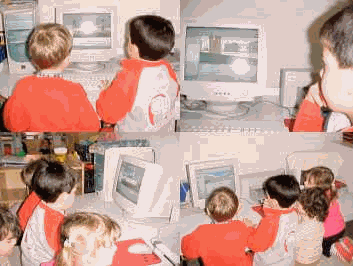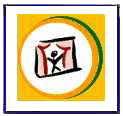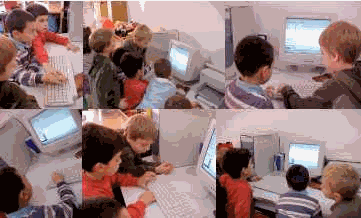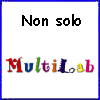|
 _
_ 
Summary
"The
Sprites in the web", didactic experience between far away
schools of different order and grade, it attracts mainly
boys and girls from three to seven years old. Using the
Sprites the teachers "narrate" how the knowledge systems
can change and get richer with new expressive and creative
possibilities with use of the communications and information
technologies, still maintaining the languages and the usual
equipment of the "traditional" school correspondence. For
the link to all the Short Relation referred to the experience
1.
General Information
The
journey of the Sprites -in and out of the web- started last
summer from some "small spirits" born from the hands of
children inside a creative laboratory that made use of many
recycled material.
The
"potential" didactic-educational journey was created with
the summer heat, from an e-mail box to another of the teachers,
it started to become possible with the fall, specially thanks
to the meeting solutions made by the children of Latina
and Soave.
In
the reality of this "fantastic" story, the journey was untied
in smaller roads and paths, with a large e-mail correspondence
. Some times the phone call shortcut was chosen, other longer
roads were maid by boxes sent by mail.
The
two distant geographical areas, tiny points on the map of
Italy, became slowly closer every time that a story, photo
or websites like http://www.descrittiva.it/calip/0203/index.htm
reached, in Latina, the attention of the childhood school
and , in Soave, those of the first elementary section involved
in the trip.
2.
Didactic Hypothesis
The
decision to go through, even with a camera, the paths of
a childs immagination was made basically from the hypothesis
of:
- To
help the aquisition of the capacity of the concepts with
the help of games of inventing and creating, knows as
the natural way of the child to research and discover
the world, also as an "instrument" ready to inspire the
strong motivation to learn;
- To
valorize the expression of the fantastic and the real
living of each child, to help him search his own self,
reinforceing his own identity;
- To
stimulate a pleasent approach to the media, promoting
the construction of knowledge
- Encourageing
the communication and the confrontation of the experiences,
of ideas and emotions through the use of a large number
of languages: from normal spoken to graphical-pictoral,
from logical-mathematical to tecnological, never the less
with instruments like drawing, writing, photography, manufactered
objects, newspapers, telemathics…
3.
Routes and Activities
The
first small creature to start the voyage was the Sprite
of Words, "all blue like the sky", born from the medieval
town as a pleasent approach to the knowledge of reading
and writing.
Arrived
in the city, he immediately started the game of the words:
beautiful, ugly and happy [1],
written on paper, boxes, blackboards and white "pages" turned
in the monitors of the computers and found inside the on-line
alphabet.
From
the counting games made during the day on the blackboards
of Ardesia placed on the walls of the class for the children
of section G of Latina was born the Sprite of the Numbers
[2] that
invited the children in the logical-mathematical world.
His arrival in Soave, after a journey via mail assured by
the italian mail, was annaunced by the boys and girls on
the Childhood school of Latina with e-mails written at the
computer of the class.
In
their exploration of the woods inside the class, after the
Sprites, the boys and girls also met the other gnomes, tiny
friendly creatures to play with at searching their identity
in the space of desguises, giving life to caracters everyone
with his own characteristics, moods, voices, walkings and
"magical powers". [3].
In
some moments the spontaneous curiosity of the children at
the aspects of nature was made by the experiences made with
water [4]. Drops
of rain, first only a few then soon many more, making their
games very wet, made possible the discovery of new scientifical
knowledges and of places far far away like Africa untill
recreating on the computer monitor...
"many colorful drops of paint". Other times the sun illuminated
the path and then it was easier to explore new routes to
understand complexed languages, made of numbers, words,
sounds, colors linking them all up in the "lowerwoods" looking
for the path of memory.
Its
like the story of "Pollicino" in the ancient story he counted
small rocks to find the safe road home, the child-sprites
experimented the use of the numbers counting and counting
each other. [5].
Soon
"Briciole" poked out, a journal made of paper, that contained
thoughts, the experiences and the ideas of the boys and
girls of the first grade class in Soave and the childhood
School of Latina adds up a "thank you" via computer.[6]
In these routes, more or less fantastic, were also involved
the parents of both of the Schools, that gave their own
tips and added up suggestions even with the internet mai
[7]l. In some occasions
they shared with the teachers and the students a few on
line programs, involving in the common route not only the
sprites, but even some of their "hairy" friends that ran
around the monitors or on the tables of the class: "Campanellino",
the tired sheep of Federico and Valeria and the "A-Mici"
to play with, a play-thought, not electrical, but made of
paper, arrived on the web directly from Sàrmede (Treviso),
the town of the fairy tale that only a few days ago had
the 20th International Childhood Illustration Show.
Even
Avatars and 3D worlds became part of the real-virtual-fantastic
world of Latina, thanks to the chat of Active Worlds and
the help of Albert, an old friend of the boys and girls,
that once again "took our hand" even if stll remaining in
Reggio Calabria [8].
After Albert other friends much more further away, but the
same very close with the on-line meetings.
|
Picture 2:
Children of three, four and five years old
"navigate"
together in the virtual worlds
(AW, 3d chat)

|
|
4.
Conclusions
The
first resaults, positve under the profile of the active
and joyful partecipation of the children and the involved
parents, cannot yet deline an asset of the experiences still
in act, wich tecnical implant and organizations may be subject
of changes.
Anyhow
the new contacts made with the teachers, the growing number
of visits made to the site, the attention recieved from
other institutions, from the Indire, from the European Commission
in occasion of the Net Days of 2002 [9],
and especially the interest demostrated by the children
in the proposed activities, induct, from a side, to think
about a possible riproductivity and, from another, to the
necessities to enlarge the fantastic-creative spaces that
sometimes in the school risks to be left to itself.
We
have also agreed to think that in this experience the tecnologies
and particularly the telemathics helped the cooperation
between teachers, teachers and children, and between children
and other children.
"The Sprites in the web" clear that the same journey will
be anyway realized with the absence of the ITC, but it will
have a minor collaboration and socialization component.
Collaboration knowledge, then, like "Aquisition of knowledge
by the subjects, abilities, acts that are the result of
a group interation, or, said more clearly, an individual
learning as a result of a group process." [A.Kaye
1994].
Thanks
to the web the possibility of contact and confrontation
for the boys and girls has grown with the opportunities
to encounter fantastic and virtual caracters like the funny
sprites of cloth and the avatars moving in the monitors
and friends that come out of the pages of the books or out
of real far away places: all magical invitations to read,
to count, to draw, to play, to curiosity, to research… -Picture
1 and 2-
"To
help this the teacher must assumer the role of the helper:
stimolating the discussion with questions that forsee an
open answer and make the students think in a creative way,
relating ideas and informations apparently not connected
and resisting to the temptation to give answers, entreating
and helping also the students in discovering by their selves."
[Trentin 1998].
Also,
a stimolating enviroment is usually a good start for curious
activities and also the creativity can be trained; clay
and cubes are only two possibilities between the many to
increment the "creative quotient", another useful way to
help this is to give a variety of stimolations with books
and internet access [Reindermann 2003].
From
the view of the user the on-line pages are getting more
and more interactive, fast in the loading, rich in functionality
and similar to the hypermedia distributed on CD-ROM [Sarti
1998], so the boys and girls had the possibility to explore
the virtual worlds wich 3d graphics had kindly "offered"
itself with the service access of large bandwith DSL that
reached the class "loading" rapidly and granting the movements
of the virtual caracters.
The
journey here reported has acted as a mediator between the
two typologies: experienced and reflective. In this case
the multimedia was used integrating with the elaborative
processes of the childs expressive and verbal world (refering
also to the creation of stories) [Calvani
1995].
In
the future it could be interesting the opening of programmable
game ambients like the ones descibed by E.K.Ackrmann seen
that until now the programmation of experiences were limited
to the ones propsed by Micromondi.
|

![]()
![]()
![]()





